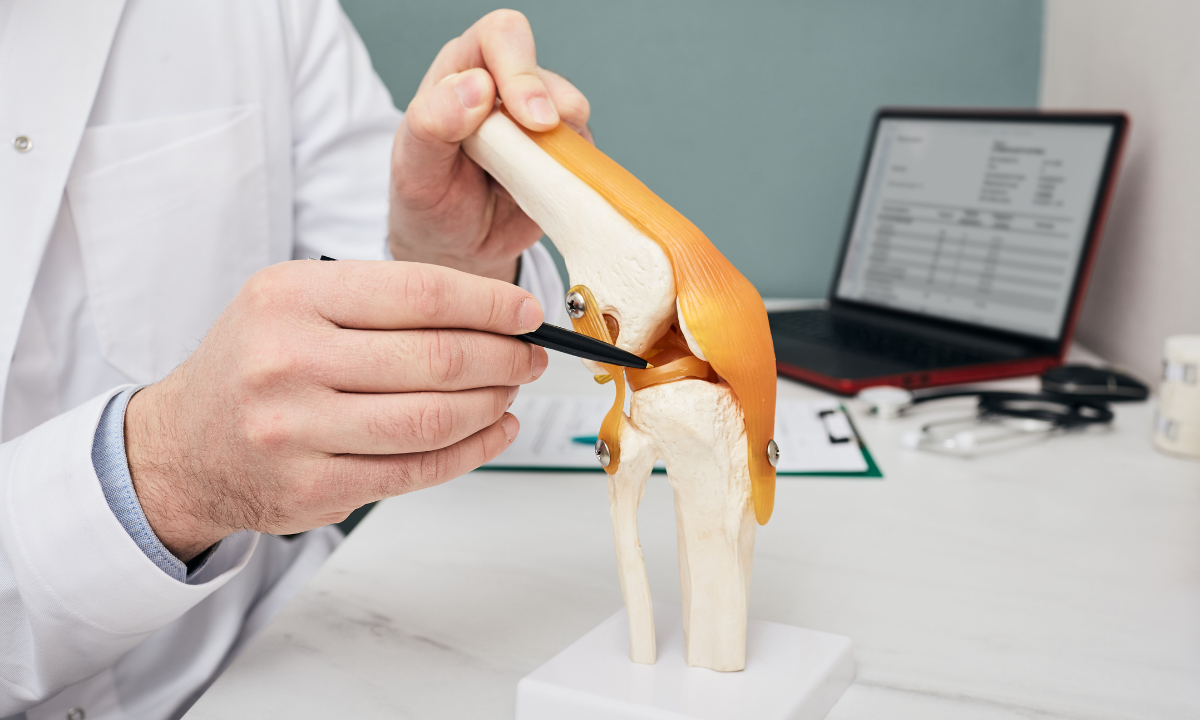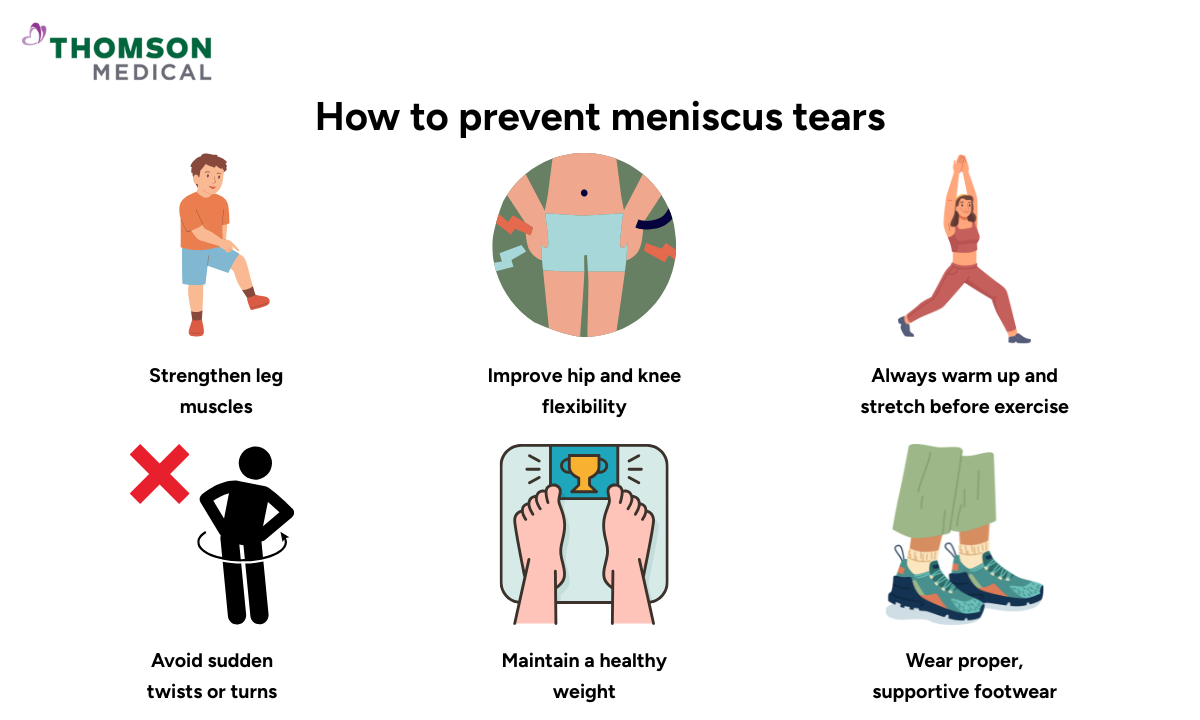Experiencing hip pain? The problem might have started in your knee. A torn meniscus can affect more than just your knee joint. Here's how the pain can travel—and what you can do about it.
What is a meniscus tear?

A meniscus tear is a common knee injury where the cartilage in your knee gets damaged. The meniscus is a C-shaped piece of tough, rubbery cartilage that sits between your thighbone (femur) and shinbone (tibia), acting as a shock absorber and helping to stabilise the joint. Each knee has two menisci—one on the inner side (medial) and one on the outer side (lateral).
A tear can happen from sudden twisting movements, deep squats, lifting heavy objects, or simply from wear and tear as you get older. If not addressed, this damage can contribute to joint degeneration over time.
How a torn meniscus can cause hip pain
A torn meniscus may start in the knee, but its effects can be felt beyond the joint. This is usually due to the body’s natural tendency to adjust its posture or movement to avoid putting pressure on the injured knee. These changes—such as limping or favouring one leg—can put extra strain on the hip muscles and joints, leading to discomfort in the hip over time.
For example, the muscles, tendons, and joints around the hip, particularly on the opposite side or even the same side as the injured knee, may begin to work harder than usual.
Over time, this added strain can lead to muscle fatigue, joint misalignment, and inflammation in the hip region. The altered biomechanics can also affect the lower back and pelvis, further increasing discomfort.
In addition, nerve signals from the knee can sometimes overlap with those from nearby areas, meaning the brain may interpret the pain as coming from the hip, which is a phenomenon known as referred pain. Therefore, while the meniscus tear itself is located in the knee, the resulting postural and mechanical changes in the body can indeed lead to pain and discomfort in the hip area.
How to tell if your hip pain is related to a knee injury
Here are key signs your hip pain may be linked to a knee issue:
Hip pain started after a knee injury:
If your hip discomfort began shortly after injuring your knee, the two may be directly connected.
Pain worsens with walking or standing:
Weight-bearing activities can aggravate hip muscles that are compensating for knee weakness or instability.
Changes in gait or posture:
Limping, favouring one leg, or shifting your weight to avoid knee pain can put extra strain on the hip joint.
Hip pain improves when knee symptoms are treated:
If hip discomfort reduces after managing your knee problem, it’s a strong indication the two are related.
No signs of direct hip damage on imaging:
If scans show no structural issues in the hip, the pain may be referred to or caused by altered biomechanics.
You also experience knee stiffness or weakness:
Reduced function in the knee can change lower-body movement patterns, affecting the hip over time.
If you notice these signs, you should request an appointment with our orthopaedic specialist to help assess the connection and develop a targeted treatment plan.
How to treat hip pain caused by a torn meniscus?
If your hip pain is linked to a torn meniscus, addressing both the knee injury and its effects on the hip is key. Working with a physical therapist can help guide your recovery and ensure safe, targeted care. Here are some effective treatment strategies:
Physical therapy and exercise
Strengthen supporting muscles:
A physiotherapist can guide you through targeted exercises to stabilise your hips and knees.
Restore natural movement:
Therapy helps correct posture and walking patterns to reduce strain on the hip.
Recommended exercises:
Clamshells, hip bridges, straight leg raises, step-ups, and gentle stretching for the hip flexors and hamstrings.
Benefits:
Improves joint function, reduces muscle imbalances, and relieves pressure on the hip.
Medications and pain relief
Anti-inflammatory medications:
Ibuprofen or naproxen can help ease pain and swelling.
Hot and cold therapy:
Apply ice to reduce inflammation or use heat to relax tight muscles.
Advanced treatments:
If pain persists, doctors may recommend corticosteroid injections or other medical interventions.
How to prevent meniscus tears

Meniscus tears often occur during physical activity, but there are steps you can take to reduce your risk. Here’s how to protect your knees and keep them healthy:
Strengthen leg muscles:
Focus on building strength in the quadriceps, hamstrings, and glutes to better support the knee joint.
Improve hip and knee flexibility:
Stretch regularly to enhance joint mobility and reduce strain during movement.
Always warm up and stretch before exercise:
Prepping your muscles helps prevent sudden injuries.
Avoid sudden twists or turns:
Be cautious during sports or when walking on uneven ground.
Maintain a healthy weight:
Excess weight increases stress on the knee and can lead to wear and tear.
Wear proper, supportive footwear:
Shoes suited for your activity can help stabilise your lower body and reduce injury risks.
FAQ
Why does my hip hurt after a knee injury?
Hip pain after a knee injury often results from compensatory movement patterns. When the knee is painful or unstable, the body naturally shifts weight or changes the way you walk to avoid discomfort. Such movements can place added stress on the hip muscles and joints, leading to pain or tightness. Over time, these changes may cause muscle imbalances and joint strain in the hip due to the reduced support from the injured knee.
Where does pain radiate with a meniscus tear?
Pain from a meniscus tear is usually centered in the knee, particularly along the joint line. However, it can sometimes radiate down the shin or up toward the thigh. In some cases, altered movement patterns may lead to secondary pain in the hip, buttock, or lower back due to increased strain on surrounding joints and muscles.
Should you walk a lot with a torn meniscus?
Light walking is generally safe if the tear is small and symptoms are mild. However, excessive walking—especially on uneven ground, inclines, or stairs—can worsen the tear and increase swelling or discomfort. If walking causes limping or pain, it's best to limit activity and consider using supportive footwear or mobility aids.
Is it okay to exercise with a meniscus tear?
Yes, but only low-impact exercise is recommended. Activities such as stationary cycling, gentle stretching, aquatic therapy, or guided physiotherapy can help maintain mobility and muscle strength. Avoid deep squats, twisting movements, running, or heavy lifting until advised by a healthcare professional.
Does a torn meniscus hurt all the time?
Not always. Some people experience pain only during specific movements like twisting, kneeling, or climbing stairs, while others may have a constant dull ache or occasional sharp pain. The frequency and intensity of pain usually depend on the size, type, and location of the tear, as well as whether the knee is swollen or unstable.
Can a torn meniscus heal on its own?
Some small tears, particularly those on the outer edge of the meniscus (the “red zone”), may heal naturally due to better blood supply. Rest, ice, compression, elevation (RICE), physical therapy, and modified activity can support healing. However, larger or degenerative tears may not heal on their own and could require medical intervention, such as surgery, to restore knee function.
Can a torn meniscus cause other problems?
Yes, a torn meniscus can lead to several complications if left untreated or not properly managed. These may include:
Chronic knee pain and swelling:
Persistent discomfort can interfere with daily activities and reduce mobility.
Joint instability:
A torn meniscus can make the knee feel wobbly or prone to giving way, increasing the risk of further injury.
Reduced range of motion:
Inflammation and mechanical blockage from the tear may limit how far you can bend or straighten your knee.
Early-onset osteoarthritis:
Long-term cartilage damage can accelerate wear and tear in the knee joint, increasing the risk of arthritis.
Compensatory issues:
Altered walking patterns may cause pain in other areas, such as the hip, lower back, or opposite leg.
The information provided is intended for general guidance only and should not be considered medical advice. For personalised recommendations and tailored advice, please consult a specialist at Thomson Medical. Request an appointment with Thomson Medical today.
For more information, contact us:
Thomson Specialists (Thomson Medical Centre) — Orthopaedic
Request an Appointment